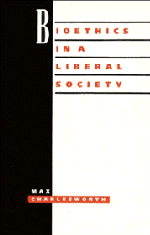5 - DISTRIBUTING HEALTH-CARE RESOURCES
Published online by Cambridge University Press: 03 May 2011
Summary
The problem of scarce resources
The problem of how health-care resources should be allocated or apportioned, so that they are distributed in both the most just and most efficient way, is not a new one. Every health system in an economically developed society is faced with the need to decide (either informally or formally) what proportion of the community's total resources should be spent on health care; how resources are to be apportioned; which human diseases and disabilities and which forms of treatment are to be given priority; which members of the community are to be given special consideration in respect of their health needs; and which forms of treatment are the most cost-effective.
What is new is that from the 1950s onwards there have been certain general changes in outlook about the finitude of resources as a whole and of health-care resources in particular, as well as more specific changes regarding the clientele of healthcare resources and the cost to the community of those resources. Thus in the 1950s and 1960s there emerged an awareness in Western societies that resources for the provision of fossil fuel energy were finite and exhaustible and that the capacity of nature or the environment to sustain economic development and population was also finite. In other words, we became aware of the obvious fact that there were ‘limits to growth’. The new consciousness that there were also severe limits to health-care resources was part of this general revelation of the obvious.
- Type
- Chapter
- Information
- Bioethics in a Liberal Society , pp. 107 - 159Publisher: Cambridge University PressPrint publication year: 1993
- 1
- Cited by



